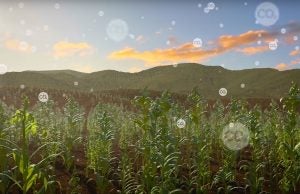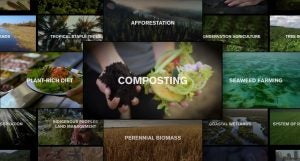According to the new documentary Kiss the Ground, soil mismanagement is a societal and ecological kryptonite. Fortunately, it’s a blight that’s easily fixed — if we can upend age-old farming practices with galvanic strides.
The challenges don’t seem that insurmountable. Kiss the Ground, which recently premiered on Netflix and was selected for the 2020 Tribeca Film Festival, effectively nurtures a reverence for that mysterious, lifegiving medium underfoot — and makes a compelling call to action. The central message is simple: The presence of dirt is a coal-mine canary, and we’re getting red flags aplenty. Thanks to our fumbling, it’s like an interconnected node that’s short-circuiting — and causing all of our ecological ills in the matrix. In addition to climate change and desertification, social problems also materialize. For example, when food systems fail, hunger and despair make for a receptive audience — a powerful recruitment tool for radical groups with dogma to spout.
The all-encompassing solution is presented as being deceptively simple: When dirt is transformed to soil through a regenerative ethic, it’s also our salvation. Most of our ongoing problems stem from a failure to take soil’s resilient properties seriously. It’s the killer app, the sustainability platform that never sunsets, if we can get it better engrained in the public (and perhaps even more importantly, political) eye. Subterrania just needs some love from Earth’s resident bipeds.
Unfortunately, this film is also another entry in a long line of documentaries with infodemic tendencies. That is, style over substance; with some laundry list “factoids” designed to go viral with no critical analysis.
It starts off unassuming enough, and to its credit, never gets totally unhinged, like Food, Inc. or Secret Ingredients does. When it does go off the factual and sensible rails, it devolves into predictable tropes about chemical agriculture, GMOs, etc. while neglecting the very contributions that these whipping-boy technologies make to the cause!
In no particular order, here are some of the take-home points.
Question Marks
Pervasive Chemophobia: My major beef (pun intended) with the entire documentary is talk about industrial chemicals (aka pesticides and fertilizers) that damage the soil. How? By supposedly killing off “good guy” microbes. The Rodale Institute indicated that the sprayed soil is completely devoid of microorganisms. Exaggerate much? I can assure you that my family farm is far from an ecological wasteland. Nearly 70 years on the same land using synthetics, and we’re more productive than ever. Hardly like we’re on borrowed time that synthetics are supposedly providing before a precipitous crash.
Disingenuous Terminology: Chemicals are viewed as chronic stresses that are “dumped” (think what that implies about the morality and stewardship of farmers). Nothing like just nonchalantly “throwing out” chemicals — like they’re somehow expendable and cheap! And who (or what) do you think is helping to degrade the big bad pesticides that we typically spray at the outrageous rate of *ounces* per acre?
An Exercise in Contrasts: There’s a segment where a regenerative farmer convert compares his farm with his neighbors. One side of the property line is vibrant, green, and biodiverse. The other is denuded, a product of being “chemically fallowed.” We’re asked which model we’d endorse. First off, who chemically fallows their land? Basically burning down all vegetation and leaving bare ground, short of some herbicide resistant weeds (another pot shot at chemical ag — never mind there are plenty of herbicide options available!).
Regenerative Rx: It’s claimed that for humans to fully capitalize on food’s nutrient density, etc., it must be grown regeneratively, namely include livestock that pasture raised, grass fed, and humanely slaughtered. While I doubt any one has issues with the latter, what would people think about livestock exposed to the elements and stressed (especially chickens exposed to predators)? Why shouldn’t livestock be under protective, often climate controlled cover? And corn is a type of grass by the way …
Smearing Ag With War/Industry References: Using goose-stepping Nazis, Zyklon B, and other dubious imagery, the film explicitly links chemical weapons of war to pesticides and fertilizers. It’s argued that both are just extensions of wartime, industrial innovations. Frankly, very few legacy chemicals are used today. And making fertilizer from the air (the Haber Process) is quite handy if you’re a fan of food security. Tell the producers about urea, a synthetic organic fertilizer and watch them explode in cognitive dissonance.
A Numbers Game: An infographic was presented claiming that it takes more nitrogen to raise a bushel of grain now than it did in 1960. Well, yields are markedly higher due to superior overall genetics. The plant can actually capitalize on its potential, because it’s being afforded all the luxuries it needs. Of course it’s going to be a heavier feeder. The more honest benchmark would be comparing nitrogen use efficiency. How much applied nitrogen does the plant actually intercept and utilize thanks to better roots and optimized physiological systems (and even precision ag that drops the fertilizer exactly where it needs to be)? I’m guessing modern varieties by a mile.
Chemophobia Part Deux: Three pounds of toxic chemicals are sprayed for every American alive! What chemicals? What are their half lives? How are they degraded? You know they’re often used as a substrate (aka food) by all those microbes that were have supposed to been killed off by said sprays, right? The Roundup Ready gene is from a bacterium that was found to be able to digest Roundup!
Field corn almost entirely sprayed with glyphosate causes cancer! Glyphosate finds its way into drinking water! Inconceivable use rates compared to 20 years ago! You mean the 22 fluid ounces per acre rate, and instrumentation with sensitivities of detection so ridiculous we can find a proverbial needle in a haystack?
Roundup in breast milk! The “studies” that had no data, no experimental controls, and weren’t peer reviewed?
A $2 billion judgment against Monsanto! I didn’t realize that juries were de facto scientists with the means to peel away the sensationalism and evaluate data. Also consider the lawyer recently convicted of trying to extort $200 million from a company that makes glyphosate. It’s about opportunistic cashing in, not a genuine public health crisis.
Celebs: My cynicism about celebs talking ag has never been higher. My eyes were rolling when Tom Brady and supermodel wife Gisele Bündchen weighed in. Their relatability quotient is about zero. I surprisingly did agree with David Arquette’s quote about how we’re poo-phobic when it comes to composting toilets. Woody Harreleson does a serviceable job with narration, short of his disingenuous intonation whenever chemicals are mentioned.

Axioms of Agreement
Tillage: Tillage is the bane of soil’s existence: It’s intrusive and destructive, and should be retired whenever possible.
Cover Crops: Keep the soil covered, plant residue is biological armor. Complementation through multispecies cover crops accelerates and feeds soil biology.
Soil can hold more CO2 than plants and the atmosphere combined. Carbon needs to be reframed as a good guy in an agricultural context. Get CO2 out of the atmosphere and under our feet, where it belongs, entombed for the ages.
Soil based carbon capture solutions are the only viable solution to manage climate change. Everything else is low hanging, unimpactful fruit. A switch to renewable energies, etc. isn’t going to alter our “legacy load” — carbon (dioxide) already in the atmosphere. This goal is achievable for a Millennial in a lifetime.
Crop Subsidies: They pervert markets, and most importantly, skew/obstruct priorities when it comes to soil conservation.

A Mixed Bag
Emulate Nature: We’re implored to “honor” natural processes. In response to the Dust Bowl, FDR — in his typical oratory style — advanced an ethic of cooperation rather than bucking nature. I’m willing to indulge to a point. Taken to its extreme — if history is any indication — that’s starvation, being at the mercy of hordes of pests and diseases. The recurring themes of paradise and Eden in the documentary lead me to believe there’s a profound disconnect between the movie’s producers and the farming system that keeps their bellies full. Ironically, it’s the abundance of food that conventional ag has afforded (granted, it’s not perfect!) that’s positioned us to have these discussions in the first place.
Experts: The melding of experts and messaging is, eclectic, to say the least. One on hand, there’s soil conservationist Ray Archuleta with the USDA’s Natural Resources Conservation Service. I’ve met Ray — he’s a dynamic individual and the premier soil health ambassador, bar none. I don’t agree with all of his contentions about “chemical” agriculture, but the crux of his message is spot on. Then there’s personnel from the Rodale Institute, an organization that touts organic farming (to be fair, I don’t recall “organic” mentioned once the entire film — regenerative seems to be the popular stand-in nowadays), sanctions various kinds of health quackery, and supports a vigorous anti-biotech agenda. When the first Rodale speaker is wearing a shirt with Kale emblazoned on the front, you know you’re in for an interesting, hyperbolic ride. Of course, kale has the dubious distinction of being the “superfood” (whatever that means).
Lapses By Commission or Omission
No-Till by Any Other Name: It was said that modern ag isn’t designed for the betterment of soil. Maybe the old iteration. Look to more contemporary times. While no-till equipment was demoed, the critical role of herbicides and biotech seed (like Roundup Ready and other non-biotech variants) was never advanced as a solution to conserve soil and manage weeds. A dual chemical/GMO system must violate their narrative.
Tim Durham’s family operates Deer Run Farm — a truck (vegetable) farm on Long Island, New York. As an agvocate, he counters heated rhetoric with sensible facts. Tim has a degree in plant medicine and is an Assistant Professor at Ferrum College in Virginia.



